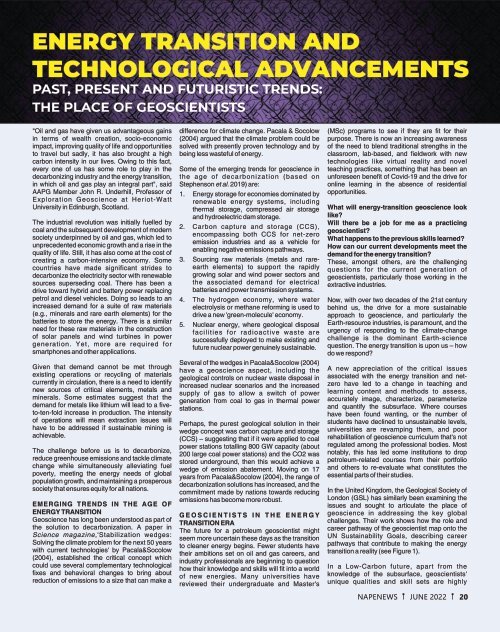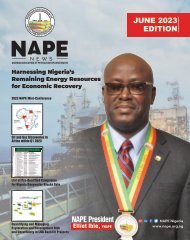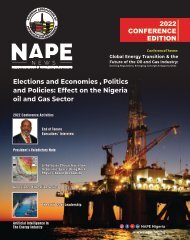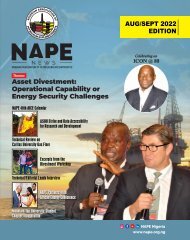NAPENews Magazine June 2022 Edition
June 2022 Edition of the NAPE News Magazine is the Mid-Year Edition. Happy reading.
June 2022 Edition of the NAPE News Magazine is the Mid-Year Edition. Happy reading.
You also want an ePaper? Increase the reach of your titles
YUMPU automatically turns print PDFs into web optimized ePapers that Google loves.
ENERGY TRANSITION AND<br />
TECHNOLOGICAL ADVANCEMENTS<br />
PAST, PRESENT AND FUTURISTIC TRENDS:<br />
THE PLACE OF GEOSCIENTISTS<br />
"Oil and gas have given us advantageous gains<br />
in terms of wealth creation, socio-economic<br />
impact, improving quality of life and opportunities<br />
to travel but sadly, it has also brought a high<br />
carbon intensity in our lives. Owing to this fact,<br />
every one of us has some role to play in the<br />
decarbonizing industry and the energy transition,<br />
in which oil and gas play an integral part", said<br />
AAPG Member John R. Underhill, Professor of<br />
Exploration Geoscience at Heriot-Watt<br />
University in Edinburgh, Scotland.<br />
The industrial revolution was initially fuelled by<br />
coal and the subsequent development of modern<br />
society underpinned by oil and gas, which led to<br />
unprecedented economic growth and a rise in the<br />
quality of life. Still, it has also come at the cost of<br />
creating a carbon-intensive economy. Some<br />
countries have made significant strides to<br />
decarbonize the electricity sector with renewable<br />
sources superseding coal. There has been a<br />
drive toward hybrid and battery power replacing<br />
petrol and diesel vehicles. Doing so leads to an<br />
increased demand for a suite of raw materials<br />
(e.g., minerals and rare earth elements) for the<br />
batteries to store the energy. There is a similar<br />
need for these raw materials in the construction<br />
of solar panels and wind turbines in power<br />
generation. Yet, more are required for<br />
smartphones and other applications.<br />
Given that demand cannot be met through<br />
existing operations or recycling of materials<br />
currently in circulation, there is a need to identify<br />
new sources of critical elements, metals and<br />
minerals. Some estimates suggest that the<br />
demand for metals like lithium will lead to a fiveto-ten-fold<br />
increase in production. The intensity<br />
of operations will mean extraction issues will<br />
have to be addressed if sustainable mining is<br />
achievable.<br />
The challenge before us is to decarbonize,<br />
reduce greenhouse emissions and tackle climate<br />
change while simultaneously alleviating fuel<br />
poverty, meeting the energy needs of global<br />
population growth, and maintaining a prosperous<br />
society that ensures equity for all nations.<br />
EMERGING TRENDS IN THE AGE OF<br />
ENERGY TRANSITION<br />
Geoscience has long been understood as part of<br />
the solution to decarbonization. A paper in<br />
Science magazine,'Stabilization wedges:<br />
Solving the climate problem for the next 50 years<br />
with current technologies' by Pacala&Socolow<br />
(2004), established the critical concept which<br />
could use several complementary technological<br />
fixes and behavioral changes to bring about<br />
reduction of emissions to a size that can make a<br />
difference for climate change. Pacala & Socolow<br />
(2004) argued that the climate problem could be<br />
solved with presently proven technology and by<br />
being less wasteful of energy.<br />
Some of the emerging trends for geoscience in<br />
the age of decarbonization (based on<br />
Stephenson et al. 2019) are:<br />
1. Energy storage for economies dominated by<br />
renewable energy systems, including<br />
thermal storage, compressed air storage<br />
and hydroelectric dam storage.<br />
2. Carbon capture and storage (CCS),<br />
encompassing both CCS for net-zero<br />
emission industries and as a vehicle for<br />
enabling negative emissions pathways.<br />
3. Sourcing raw materials (metals and rareearth<br />
elements) to support the rapidly<br />
growing solar and wind power sectors and<br />
the associated demand for electrical<br />
batteries and power transmission systems.<br />
4. The hydrogen economy, where water<br />
electrolysis or methane reforming is used to<br />
drive a new 'green-molecule' economy.<br />
5. Nuclear energy, where geological disposal<br />
facilities for radioactive waste are<br />
successfully deployed to make existing and<br />
future nuclear power genuinely sustainable.<br />
Several of the wedges in Pacala&Socolow (2004)<br />
have a geoscience aspect, including the<br />
geological controls on nuclear waste disposal in<br />
increased nuclear scenarios and the increased<br />
supply of gas to allow a switch of power<br />
generation from coal to gas in thermal power<br />
stations.<br />
Perhaps, the purest geological solution in their<br />
wedge concept was carbon capture and storage<br />
(CCS) – suggesting that if it were applied to coal<br />
power stations totalling 800 GW capacity (about<br />
200 large coal power stations) and the CO2 was<br />
stored underground, then this would achieve a<br />
wedge of emission abatement. Moving on 17<br />
years from Pacala&Socolow (2004), the range of<br />
decarbonization solutions has increased, and the<br />
commitment made by nations towards reducing<br />
emissions has become more robust.<br />
G E O S C I E N T I S T S I N T H E E N E R G Y<br />
TRANSITION ERA<br />
The future for a petroleum geoscientist might<br />
seem more uncertain these days as the transition<br />
to cleaner energy begins. Fewer students have<br />
their ambitions set on oil and gas careers, and<br />
industry professionals are beginning to question<br />
how their knowledge and skills will fit into a world<br />
of new energies. Many universities have<br />
reviewed their undergraduate and Master's<br />
(MSc) programs to see if they are fit for their<br />
purpose. There is now an increasing awareness<br />
of the need to blend traditional strengths in the<br />
classroom, lab-based, and fieldwork with new<br />
technologies like virtual reality and novel<br />
teaching practices, something that has been an<br />
unforeseen benefit of Covid-19 and the drive for<br />
online learning in the absence of residential<br />
opportunities.<br />
What will energy-transition geoscience look<br />
like?<br />
Will there be a job for me as a practicing<br />
geoscientist?<br />
What happens to the previous skills learned?<br />
How can our current developments meet the<br />
demand for the energy transition?<br />
These, amongst others, are the challenging<br />
questions for the current generation of<br />
geoscientists, particularly those working in the<br />
extractive industries.<br />
Now, with over two decades of the 21st century<br />
behind us, the drive for a more sustainable<br />
approach to geoscience, and particularly the<br />
Earth-resource industries, is paramount, and the<br />
urgency of responding to the climate-change<br />
challenge is the dominant Earth-science<br />
question. The energy transition is upon us – how<br />
do we respond?<br />
A new appreciation of the critical issues<br />
associated with the energy transition and netzero<br />
have led to a change in teaching and<br />
learning content and methods to assess,<br />
accurately image, characterize, parameterize<br />
and quantify the subsurface. Where courses<br />
have been found wanting, or the number of<br />
students have declined to unsustainable levels,<br />
universities are revamping them, and poor<br />
rehabilitation of geoscience curriculum that's not<br />
regulated among the professional bodies. Most<br />
notably, this has led some institutions to drop<br />
petroleum-related courses from their portfolio<br />
and others to re-evaluate what constitutes the<br />
essential parts of their studies.<br />
In the United Kingdom, the Geological Society of<br />
London (GSL) has similarly been examining the<br />
issues and sought to articulate the place of<br />
geoscience in addressing the key global<br />
challenges. Their work shows how the role and<br />
career pathway of the geoscientist map onto the<br />
UN Sustainability Goals, describing career<br />
pathways that contribute to making the energy<br />
transition a reality (see Figure 1).<br />
In a Low-Carbon future, apart from the<br />
knowledge of the subsurface, geoscientists'<br />
unique qualities and skill sets are highly<br />
NAPENEWS JUNE <strong>2022</strong> 20










